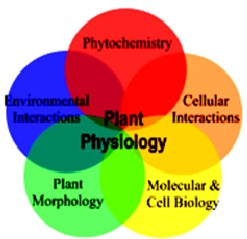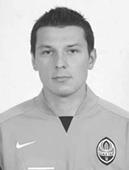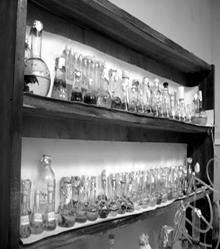Physiology of plants and animals
Although you may place organisms without dif- ficulty in either the plant or the animal kingdom, it is essential to know the basic differences between these two groups. That`s why we can distinguish physiol- ogy of plants and animals.
Plant physiology. It is a subdiscipline of botany concerned with the functioning, or physiology of plants. Closely related fields include plant morphol-
 ogy (structure of plants), plant ecology (interactions with the environ-
ogy (structure of plants), plant ecology (interactions with the environ-
ment), photochemistry (biochemistry of plants), cell biology, and molecular biol- ogy. The scope of plant physiology as a
discipline may be divided into several major areas of research.
First, the study of photochemistry (plant chem- istry) is included within the domain of plant physiol- ogy. To function and survive, plants produce a wide array of chemical compounds not found in other or- ganisms. Photosynthesis requires a large array of pigments, enzymes, and other compounds to function. Secondly, plant physiology includes the study of bio- logical and chemical processes of individual plant
cells. Plant cells have a number of features that distin- guish them from cells of animals, and which lead to major differences in the way that plant life behaves and responds differently from animal life. Thirdly, plant physiology deals with interactions between cells, tissues, and organs within a plant. Different cells and tissues are physically and chemically specialized to perform different functions. Fourthly, plant physiolo- gists study the ways that plants control or regulate in- ternal functions. Like animals, plants produce chemi- cals called hormones which are produced in one part of the plant to signal cells in another part of the plant to respond. Finally, plant physiology includes the study of how plants respond to conditions and varia- tion in the environment, a field known as environmental physiology.
Animal physiology. It is the study of animal functions. Animal physiology is subdivided into the four main parts, such as general physiology, special physiology, comparative physiology and age physiol- ogy.
General physiology deals with the analysis of such universal and important processes as blood circu- lation, metabolism, respiration etc. Special physiology applies general physiological principles in order to in- vestigate characteristics of a particular animal species. Comparative physiology concentrates on similarities and differences of physiological functions of various living organisms. The problem of how physiological functions change with animal age is of special interest to age physiology.
The main approach in animal physiology is to study the evolutionary origins of the physiological mechanisms in order to understand the significance of these mechanisms for modern animals. Modern physi- ology which is based on chemical, physical and ana- tomical methods investigates biological organization of the animal body at different levels, that is, cells, tis- sues, organs.
One of the parts of special physiology is de- voted to farm animal physiology. The aim of this sci- ence is not only to study physiological functions of the farm animal body, but to control them in order to in- crease the production of eggs, offspring, milk, meat and wool.
Other major branches of scientific study that have grown out of physiology research include bio- chemistry, biophysics, biomechanics, pharmacology, cytology as well as genetics which are known as the biological bases for rational animal husbandry.
12. Translate the sentences into English using the words from the text.
1) Физиология растений — это наука о функ- циональной активности растительных организмов.
2) Задачи физиологии растений: изучение за- кономерностей жизнедеятельности растений, раз- работка теоретических основ получения макси- мальных урожаев сельскохозяйственных культур, разработка установок для осуществления процес- сов фотосинтеза в искусственных условиях.
3) Фотосинтез — процесс образования ор-
ганических веществ из углекислого га- за и воды на свету при участии фотосинтетических пигментов.
4) Физиология растений – биологическая наука, изучающая общие закономерности жизне- деятельности растительных организмов.
5) Сегодня молекулярная биология распола- гает обширным арсеналом методов, позволяющих решать самые передовые и самые сложные задачи, стоящие перед учёными.
6) Вся история человеческого общества - это история его борьбы за выживание, исто- рия взаимодействия с окружающей средой.
7) Каждая клетка растений данного вида содержит в своем ядре одинаковый набор (или на- боры) хромосом из строго определенного числа разных.
8) Циркуляция крови может быть восстанов- лена, например, с помощью следующих пище- вых добавок: Витамин С улучшает тонус сосудов и в сочетании с витамином Е улучшает эндотели- альную функцию.
9) Возрастная физиология – раздел физио- логии человека и животных, изучающий законо- мерности становления и развития физиологиче- ских функций организма на протяжении онтоге- неза — от оплодотворения яйцеклетки до конца жизни.
13. Fill in the gaps in these sentences:
1) Plant physiology is a subdiscipline of
concerned with the functioning, or
physiology of plants.
2) To function and survive, plants produce a wide array ofnot found in other organ- isms.
3) Plant cells have a which restricts the shape of plant cells and thereby limits the flexibility and mobility of plants.
4) Different cells and tissues are physically and chemically specialized to perform different.
5) Like animals, plants produce chemicals calledwhich are produced in one part of the plant to signal cells in another part of the plant to re- spond.
6) Animal physiology is subdivided into the four main parts, such as,, and.
7) The main approach in animal physiology is to study theof the physiological mechanisms in order to understand the significance of these mecha- nisms for modern animals.
14.
|
15. Answer the following questions according to the ideas of the text.
1) What does physiology study?
2) What are the main parts of physiology?
3) What stimulated the development of animal physiology?
4) What problems are of special interest to animal physiologists?
5) What are the main principles of physiological study?
6) How can the knowledge of physiological reac- tions help to maintain healthy farm animals?
7) What sciences are based on physiology re- search?
8) Tell the four main parts of animal physiology. What is the main approach in animal physiology?
16. Arrange the following statements in their logical order. Explain and expand them.
- Plant physiology deals with interactions be- tween cells, tissues, and organs within a plant.
- Plant physiology includes the study of biologi- cal and chemical processes of individual plant cells.
- Plant physiology is a subdiscipline of botany concerned with the functioning, or physiology of plants.
- Other major branches of scientific study that have grown out of physiology research.
- Plant physiology includes the study of how plants respond to conditions and variation in the envi- ronment.
- Animal physiology is the study of animal functions.
- The field of plant physiology includes the study of all the internal activities of plants
- The study of phytochemistry (plant chemistry) is included within the domain of plant physiology.
- The main approach in animal physiology is to study the evolutionary origins of the physiological mechanisms.
17. Make a plan of this text. Add key words in it if necessary.
18. Retell this text using your plan.
19. Translate the text into English using the words you’ve learned.
Оплодотворение у высших видов - это слия- ние яйцеклетки и сперматозоида. Оно происходит в яйцеводе. Наилучшие условия для этого обычно в пределах 12 ч. после выхода яйца из яичника. Многочисленные сперматозоиды приближаются к яйцеклетке, окружают ее, вступают в контакт с ее оболочкой.
Однако в яйцеклетку проникает только один сперматозоид, после чего вокруг яйцеклетки обра- зуется оболочка оплодотворения, препятствующая проникновению других сперматозоидов. В резуль-
тате слияния двух ядер с галоидными наборами хромосом образуется диплоидная зигота (клетка, которая является одноклеточным организмом но- вого дочернего поколения).
20. Make a report:
“What problems are animal and plant physiolo- gists investigating now?”
21. Study the example of CV (curriculum vitae).
 Make Conclusions about the form of the resume.
Make Conclusions about the form of the resume.
CV (CURRICULUM VITAE)
Perminov Vitaly
14 apt., 161, Leninast., Izhevsk, Udmurt republic, Russia 426000
Phone: +7(3412) 891234
Mobile: +7 916 7894 689
SUMMARY OF QUALIFICATION
· Languages:English - very good, German – satis- factory
· Enthusiastic, cooperative and detail oriented. Studying very quickly.
· Good knowledge of laboratory equipment.
Date of birth: 07/03/1987 Marital status: Single Nationality: Russian
EDUCATION:
Udmurt State University, Biotechnological Fac- ulty. Major – biochemistry. Expecting graduating date - 2015.
Santa-Lingua language school, advanced course of English. Certificate.
WORK EXPERIENCE:
14.03.2008 - 06.07.2009 – Finam Ltd., economist in financial group.
· work with a bank
· work with clientele
06.07.2006 - 18.08.2007 – UdSU, lab assistant.
· work with lab equipment
· chromatography analysis
ADDITIONAL SKILLS:
Hobbies: chemistry (diploma for the 3rd place in regional tour in chemistry), swimming, boxing.
INTERSTS:
Any computer work, experience of office, seller skills, advertisement experience, took part in ad- vancement of new medicines to foreign markets,
can swim well, housekeeping, kitchen works and take care of children.
Interesting in studying and improving my English skills, visit dif. countries (US best of all).
22. Write your own CV. You can imagine your- self a well-known scientist or write the CV from your student’s position as well.
Unit 8 Biochemistry
Do you know the subject of biochemistry? What is a biomolecule?
What kind of biomolecules do you know? What is DNA?
1. Read the text about biochemistry and trans- late it.
Biological chemistry
 Biochemistry, sometimes called biological chem- istry, is the study of chemical processes in living or- ganisms, including, but not limited to, living matter. Biochemistry governs all living organisms and living processes. By controlling information flow through biochemical signaling
Biochemistry, sometimes called biological chem- istry, is the study of chemical processes in living or- ganisms, including, but not limited to, living matter. Biochemistry governs all living organisms and living processes. By controlling information flow through biochemical signaling
and the flow of chemi- cal energy through me- tabolism, biochemical processes give rise to the incredible complex- ity of life. Much of biochemistry deals with the structures and functions of cellular components such as proteins, carbohy-
drates, lipids, nucleic acids and other biomolecules al- though increasingly processes rather than individual molecules are the main focus. Over the last 40 years biochemistry has become so successful at explaining living processes that now almost all areas of the life sciences from botany to medicine are engaged in bio-
been a hard-line between these disciplines in terms of content and technique. Today the terms molecular bi- ology and biochemistry are nearly interchangeable.
Vocabulary
chemical research. Today the main focus of pure bio- chemistry is in understanding how biological mole- cules give rise to the processes that occur within living cells which in turn relates greatly to the study and un- derstanding of whole organisms.
Among the vast number of different bio- molecules, many are complex and large molecules (called biopolymers), which are composed of similar repeating subunits (called monomers). Each class of polymeric biomolecule has a different set of subunit types. For example, a protein is a polymer whose sub- units are selected from a set of 20 or more amino ac-
amino acid biopolymer cell membrane transport complex (adj)
endocrine system engage (v) enzyme-catalyzed reaction
give rise to (v) govern (v)
in terms of interchangeable lipids
living matter metabolism monomer nucleic acid occur (v) protein subunit transduction
ids. Biochemistry studies the chemical properties of important biological molecules, like proteins, and in particular the chemistry of enzyme-catalyzed reac- tions.
The biochemistry of cell metabolism and the
2. Fill in the gaps in this sentences:
1) Biochemistry is the study ofin living organisms.
2) Much of biochemistry deals withof cellular components such as.
endocrine system has been extensively described.
3) Over the last
years biochemistry has
Other areas of biochemistry include the genetic code (DNA, RNA), protein synthesis, cell membrane trans-
become so successful at explaining living processes.
4) Today the main focus of pure biochemistry is
port, and signal transduction.
in
how biological molecules give rise to the
Researchers in biochemistry use specific tech- niques native to biochemistry, but increasingly com- bine these with techniques and ideas from genetics,
processes thatwithin living cells.
5) Each class of polymerichas a different set of subunit types.
molecular biology and biophysics. There has never
6)
is a polymer whose subunits are se-
lected from a set of 20 or more amino acids.
7) The biochemistry of cell and the
system has been extensively described.
8) Researchers in biochemistry use specific
native to biochemistry.
9) Today the termsand biochemistry are nearly interchangeable.
3. Make sentences in English with words stated below:
a) govern, give rise to, engage, occur;
b) protein, amino acid, carbohydrates, lipid, amino acid, endocrine system.
4. Circle any additional unknown words/phrases in the article. In pairs/groups, use your dictionaries to understand the meanings. Write definitions to 3 of them.
5. Answer the questions to check your compre- hension.
1) What is an object for this study?
2) When did biochemistry become so successful at explaining living processes?
3) What is the main focus of pure biochemistry?
6. Prepare a report about the role of biochemis- try in modern life. Include the following ideas:
· What is biochemistry
· What is biomolecule and what is its impor- tance
· Biochemical techniques and its importance
· The application of biochemistry in modern life
Be ready to tell your report to your class.
7. Give definition of words: Metabolism – …….. Protein – ……..
Enzyme-catalyzed reaction – ……. Nucleic acid – ……..
Biopolymer – ……….
8.
|
9. Study additional notions concerning biochem- istry and explain them.
Chromotography Coomassie dye Electrophoresis Peptides
ELSA
IgG Enzyme
Isoelectric point Centrifuge Peptin
Polyacrylamide gel Distillated water
10. Translate the sentences with the words from vocabulary after the text.
1) Четвертичная структура белка состоит из субъединиц-доменов.
2) ИФА применяется для качественного и ко- личественного определения биомолекул.
3) Ферменты катализируют как прямую, так и обратную реакцию.
4) Передача нервного импульса идет посред- ством медиаторов.
5) Хромография – метод разделения белков по массе.
6) Краситель кумасси используется для окра- шивания полиакриламидного геля.
7) Изоэлектрическая точка означает электро-
нейтральное положение белка.
8) Дистиллированная вода используется для мытья лабораторной посуды, добавления в раство- ры и многих других целях.
9) Нуклеиновые кислоты несут закодирован- ную информацию.
10) При повышении температуры тела чело- века до 40° происходит денатурация белка.
11. Open the brackets and use the comparative form of the adjectives and adverbs.
1) This exercise is (simple) than that one. 2) Why are you talking? Please be (quiet). 3) New dis- tricts of Moscow are (beautiful) than the old ones. 4) He is (clever) than his brother. 5) My (old) sister is 4 years (old) than me. 6) There are (many) customers on Saturdays than on weekdays. 7) Are expensive things (good) than cheap ones? 8) Is English grammar (diffi- cult) than Russian grammar? 9) He has made (few) mistakes than yesterday. 10) She had to give us (far) information though she didn't want to.
12. Translate into English using the proper de- grees of the words in bold type.
1) Возьмите этот чемодан (suitcase), он легче вашего. 2) В районе West End находятся самые до- рогие магазины. 3) Что ты собираешься делать дальше? 4) Я думаю, что он старше вас, помоложе меня. 5) Это самый талантливый студент в нашей группе. 6) Хотя у нас были самые плохие места,
нам очень понравился спектакль (performance). 7)
Где ближайшее почтовое отделение? 8)Последний поезд прибывал в полночь. 9)Последние известия были совсем неинтересные. 10) Они получили до- полнительные сведения по этому вопросу.
13. Put the adverbsin the right place.
E.g.: These books are old (very). — These books are very old.
1) I hate travelling by air (really). 2) She trusted him (entirely). 3) I understand your situation (fully).
4) It is not his fault. He did not want it to happen (at all). 5) The rain spoiled my day (completely). 6) We did the job quickly (fairly). 7) Though he tried to per- suade her, she believed his story (hard, half). 8) He be- lieves that he is right (firmly). 9) The prices are cheap at the hotel (reasonably). 10) I was tired to eat (too, even).
14. Open the brackets and give the comparative or superlative degree of the following adjectives and adverbs. Add articles if necessary.
1) That is (incredible) story I have ever heard.
2) It is not always (bright) students who do well in tests. 3) I think, cotton shirts are much (comfortable) to wear! 4) Which is (deep), Lake Michigan or Lake Superior? 5) She is far (self-confident) than she used to be. 6) (tall) man among the guests is a basketball player. 7) I like both of them, but I think Kate is (easy) to talk to. 8) Most people are (well off) than their par- ents used to be. 9) She has a lot to be thankful for; but (sad) thing of all is that she does not realize it. 10)
You look a lot (sad) than you did last time I saw you.
15. Read the text and title it.
